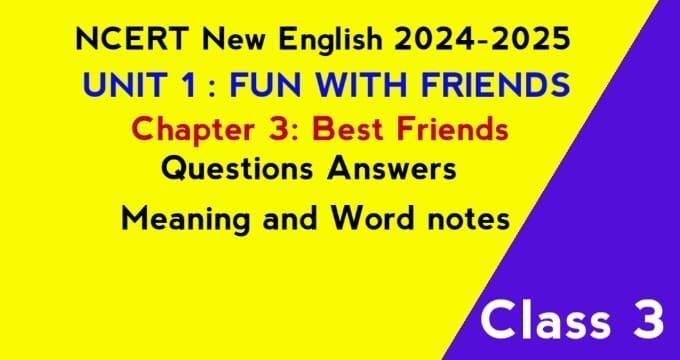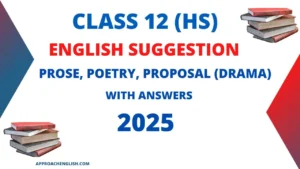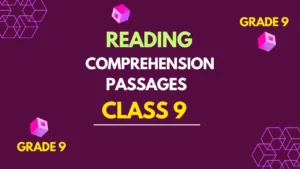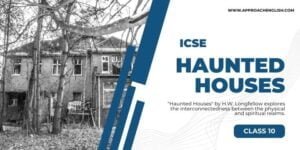Best Friends Class 3 Chapter 3 NCERT Questions Answers 2025 is a vital part of the Grade 3 English curriculum for 2024-2025 in all CBSE schools nationwide, following the NCERT-designed textbook “Santoor.”
Additionally, all text-based questions, answers, meanings, and word notes for Best Friends Class 3 Chapter 3 for the Grade 3 English curriculum in the academic year of 2024-2025 are provided here, beginning from the 2024-2025 session.
Summary of Best Friends Class 3 Chapter 3
The story is about four friends: Circle, Square, Triangle, and Rectangle. Each of them believes they are the best because of their unique shapes.
Circle boasts that it is the best because it is round, beautiful, and has no sharp edges. Children use it to draw smiling faces, making it special.
Triangle argues it is the best because it is beautiful with its three sides. Children use it to draw mountains and enjoy snacks shaped like triangles.
Rectangle disagrees with the others, claiming it is the best because it has four sides, two of which are equally long and two are equally short. Children enjoy biscuits and chocolates in rectangular shapes, and many things are used in these shapes.
Despite their arguments, the friends cannot decide who is the best. However, when they meet a star, they realize that each of them is unique in their way, and it’s impossible to determine who is the best among them.
अनुबाद:
कहानी चार दोस्तों के बारे में है: वृत्त, वर्ग, त्रिभुज और आयत। उनमें से प्रत्येक का मानना है कि वे अपने अद्वितीय आकार के कारण सर्वश्रेष्ठ हैं।
सर्कल का दावा है कि यह सर्वश्रेष्ठ है क्योंकि यह गोल है, सुंदर है और इसमें कोई नुकीला किनारा नहीं है। बच्चे इसका उपयोग मुस्कुराते हुए चेहरे बनाने के लिए करते हैं, जो इसे विशेष बनाता है।
ट्राएंगल का तर्क है कि यह सर्वश्रेष्ठ है क्योंकि यह अपनी तीन भुजाओं से सुंदर है। बच्चे इसका उपयोग पहाड़ बनाने और त्रिकोण के आकार के स्नैक्स का आनंद लेने के लिए करते हैं।
आयत दूसरों से असहमत है, उसका दावा है कि यह सबसे अच्छा है क्योंकि इसकी चार भुजाएँ हैं, जिनमें से दो समान रूप से लंबी हैं और दो समान रूप से छोटी हैं। बच्चे आयताकार आकृतियों में बिस्कुट और चॉकलेट का आनंद लेते हैं और इन आकृतियों में कई चीजों का उपयोग किया जाता है।
अपने तर्कों के बावजूद, मित्र यह तय नहीं कर पाते कि सर्वश्रेष्ठ कौन है। हालाँकि, जब वे किसी सितारे से मिलते हैं, तो उन्हें एहसास होता है कि उनमें से प्रत्येक अपने तरीके से अद्वितीय है, और यह निर्धारित करना असंभव है कि उनमें से सर्वश्रेष्ठ कौन है।
People also ask
| Chapter 5: Talking Toys | |
| Chapter 3: Best Friends | Chapter 4: Out in the Garden |
| Chapter 1: Colour | Chapter 2: Badal and Moti |
Line-by-Line Meaning & Word Notes of Best Friends Class 3 Chapter 3
Let us read
Para 1
There were four friends – Circle, Square, Triangle and Rectangle.
चार मित्र थे – वृत्त, वर्ग, त्रिभुज और आयत।
One day there began a fight between the friends.
एक दिन दोस्तों के बीच झगड़ा होने लगा।
Each of them said they were the best.
उनमें से प्रत्येक ने कहा कि वे सर्वश्रेष्ठ हैं।
Word Notes:
Circle – वृत्त – a round plain figure
Square – वर्ग – a plane figure with four equal straight sides and four right angles.
Triangle – त्रिभुज – a plane figure with three straight sides and three angles.
Rectangle – आयतक्षेत्र – a plane figure with four straight sides and four right angles, especially one with unequal adjacent sides, in contrast to a square.
Began – शुरू किया – started
Para 2
Circle said, “I am the best! I am round and beautiful.
सर्कल ने कहा, “मैं सर्वश्रेष्ठ हूं! मैं गोल और सुन्दर हूँ.
I have no sharp edges.
मेरे पास कोई तेज़ धार नहीं है.
Children use me to draw a smiling face.
बच्चे मुस्कुराता हुआ चेहरा बनाने के लिए मेरा उपयोग करते हैं।
There are so many beautiful things in my shape.
मेरे आकार में बहुत सारी खूबसूरत चीज़ें हैं।
I am the best!”
मैं सबसे अच्छा हूँ!”
Word Notes:
sharp edges – तीक्ष्ण किनारे – acute outside limit of an object
shape – आकार – figure
smiling face – मुस्कराता चेहरा – laughing figure
Para 3
The other shapes refused to agree with the circle.
अन्य आकृतियों ने वृत्त से सहमत होने से इनकार कर दिया।
Square then said, “I am the best! I have four sides and all of them are equal in size.
स्क्वायर ने तब कहा, “मैं सर्वश्रेष्ठ हूँ! मेरी चार भुजाएँ हैं और वे सभी आकार में समान हैं।
Children eat many sweets which are square in shape.
बच्चे कई मिठाइयाँ खाते हैं जो चौकोर आकार की होती हैं।
I look very beautiful and so I am the best.”
मैं बहुत सुंदर दिखती हूं और इसलिए मैं सर्वश्रेष्ठ हूं।”
Word Notes:
refused – अस्वीकार करना – denied
equal in size – आकार में बराबर – similar in size
Para 4
After listening to this, Triangle said in a loud voice, “I am the best! Just look at me! I am so beautiful.
यह सुनकर ट्रायंगल ने ऊँची आवाज़ में कहा, “मैं सर्वश्रेष्ठ हूँ! बस मुझे देखो! मैं बहुत खूबसूरत हूँ।
I have three sides.
मेरी तीन भुजाएं हैं.
Children use me to draw mountains.
बच्चे मेरा उपयोग पहाड़ बनाने में करते हैं।
They enjoy many yummy snacks in my shape.
वे मेरे आकार में कई स्वादिष्ट स्नैक्स का आनंद लेते हैं।
So, I am the best!”
तो, मैं सर्वश्रेष्ठ हूँ!”
Word Notes:
Listening – सुनना – hearing
mountains – पहाड़ों – hills
yummy – स्वादिष्ट – delicious
snacks – नाश्ता – breakfast
Para 5
Listening to the other three friends, Rectangle laughed aloud.
बाकी तीन दोस्तों की बात सुनकर रेक्टेंगल जोर से हंसा।
“Of course not.
“बिल्कुल नहीं।
No one can be better than me.
मुझसे बेहतर कोई नहीं हो सकता.
I have four sides.
मेरी चार भुजाएं हैं.
Two are equally long and two are equally short.
दो समान रूप से लंबे हैं और दो समान रूप से छोटे हैं।
I look so beautiful.
मैं बहुत सुंदर दिखती हूं.
Children enjoy biscuits and chocolates in rectangle shape.
बच्चे आयताकार आकार में बिस्कुट और चॉकलेट का आनंद लेते हैं।
They also use so many things in my shape.
वे मेरे आकार की बहुत सारी चीजों का उपयोग भी करते हैं।
I am the best!” said the rectangle.
मैं सबसे अच्छा हूँ!” आयत ने कहा.
Word Notes:
equally – समान रूप से – evenly
enjoy – आनंद लेना – take pleasure
What do you think will happen now?
Para 6
The friends could not decide who was the best among them.
मित्र यह निर्णय नहीं कर पा रहे थे कि उनमें से सर्वश्रेष्ठ कौन है।
They decided to ask the first they meet.
उन्होंने तय किया कि सबसे पहले मिलने पर पूछेंगे।
Word Notes:
decide – तय करना – settle
among – के बीच- amid
meet – मिलो – visit
Para 7
After some time, they met a star.
कुछ समय बाद उनकी मुलाकात एक सितारे से हुई।
They stopped her and told her of their fight.
उन्होंने उसे रोका और अपनी लड़ाई के बारे में बताया।
They asked her to decide who was the best among them.
उन्होंने उससे निर्णय लेने को कहा कि उनमें से सर्वश्रेष्ठ कौन है।
Word Notes:
some time – कभी कभी – rare
star – तारा – a fixed luminous point in the night sky
stopped – रोका हुआ – stand still
fight – झगड़ा करना – quarrel
Para 8
The star was wise.
सितारा बुद्धिमान था.
She looked at all of them.
उसने उन सभी को देखा।
She thought for a while.
उसने कुछ देर सोचा.
Then she said, “All of you are friends.
फिर बोली, “तुम सब दोस्त हो
Then why should you fight?
फिर तुम्हें क्यों लड़ना चाहिए?
Let me tell you something very important.
मैं तुम्हें एक बहुत ही महत्वपूर्ण बात बताता हूँ।
Do you know what you could do if you were together?
क्या आप जानते हैं कि यदि आप एक साथ होते तो आप क्या कर सकते थे?
You could create the most beautiful pictures and patterns!
आप सबसे सुंदर चित्र और पैटर्न बना सकते हैं!
Just look around.
एक बार चारों ओर देख लो।
We find amazing designs and things in all the shapes.
हमें सभी आकारों में अद्भुत डिज़ाइन और चीज़ें मिलती हैं।
So, stop fighting.
तो, लड़ना बंद करो.
Together we all can create wonders.“
हम सब मिलकर चमत्कार कर सकते हैं।”
Word Notes:
wise – बुद्धिमान – intelligent
looked at – देखा – view
thought – सोचा – idea
something – कुछ – anything
important – महत्वपूर्ण – vital
Together – एक साथ- side by side
Create – बनाएं – build
Patterns – प्रतिरूप – a repeated decorative design.
Just – अभी – exactly
Fighting – लड़ाई करना – dispute
create – निर्माण करना – build
Wonders – चमत्कार – miracle
Para 9
The friends realised their mistake and promised each other that they would never fight again.
दोस्तों को अपनी गलती का एहसास हुआ और उन्होंने एक-दूसरे से वादा किया कि वे फिर कभी नहीं लड़ेंगे।
They remained best friends forever.
वे सदैव सबसे अच्छे दोस्त बने रहे।
Word Notes:
Realised – समझना – understood
Mistake – गलती – error
Promised – वादा – obligation
Never – कभी नहीं – by no means
remained – रहना – stay
Forever – हमेशा के लिए – continually
Textual Questions Answers of Best Friends Class 3 Chapter 3
Let us think
Answer the following. [निम्नलिखित का उत्तर दें।]
1. Who were the four friends? [चार मित्र कौन थे?]
Ans: Circle, Square, Triangle, and Rectangle are the four friends.
2. Why were they fighting? [वे क्यों लड़ रहे थे?]
Ans: They were fighting to decide who was the best among them.
3. Who helped them to end their fight? [उनकी लड़ाई ख़त्म करने में किसने उनकी मदद की?]
Ans: The wise star helped them to end their fight.
4. What lesson did the friends learn in the end?
Ans: In the end, the friends realized their mistake and promised each other that they would never fight again because they learned the lesson that together they all can create wonders. The lesson they learned is that “Unity is strength”.
5. Write ‘T’ for true and ‘F’ for false. [सत्य के लिए ‘T’ और असत्य के लिए ‘F’ लिखें।]
a) The circle does not have sharp edges. – T
b) A square has four sides but not all of them are equal in size – F
c) The triangle has two sides – F
d) The friends could decide who was the best among them. – F
6. Who is your friend? What are the things you can do when your friend helps you? [आपका दोस्त कौन है? जब आपका मित्र आपकी सहायता करता है तो आप क्या कर सकते हैं?]
Ans: My friend is Srinjoy/Pritha. I enjoy spending time with him/her and when I need him/her.
When my friend helps me, there are many things we can do together like, having fun together, playing games, watching cartoons, and doing our homework together.
7. Look around you. Talk about the shapes of what you see. [अपने आसपास देखो। आप जो देखते हैं उसके आकार के बारे में बात करें।]
Ans: When I look around me, I can see the following shapes:
Square – My computer screen is square-shaped.
Circle – The clock on the wall has a circular face.
Rectangle – The door to the room is rectangular.
Triangle – The corner of the desk forms a triangular shape.
Cylinder – My water bottle is in the shape of a cylinder.
Sphere – There’s a globe on the shelf that is shaped like a sphere.
Cone – The lampshade on the desk lamp is cone-shaped.
Oval – The mirror on the wall is oval-shaped.
Let us speak in Best Friends Class 3 Chapter 3
Divide into groups of 5. Each of you will be one character in the story — circle, square, triangle, rectangle and the star. Take turns and read out the story. Enjoy by adding actions to what you say.
5 के समूहों में विभाजित करें। आप में से प्रत्येक कहानी में एक पात्र होगा – वृत्त, वर्ग, त्रिकोण, आयत और तारा। बारी-बारी से कहानी पढ़ें। आप जो कहते हैं उसमें क्रियाएँ जोड़कर आनंद लें।
Let us learn
Read the following lines. [निम्नलिखित पंक्तियाँ पढ़ें.]
A pigeon and an ant became friends.
एक कबूतर और एक चींटी दोस्त बन गए।
Notice that we used ‘a’ before ‘pigeon’ and ‘an’ before ‘ant’. We use ‘a’ before singular nouns that begin with consonants. ‘An’ is used before singular nouns that begin with vowel sounds (a, e, i, o, u). Using This information, fill up the following blanks.
ध्यान दें कि हमने ‘कबूतर’ से पहले ‘ए’ और ‘चींटी’ से पहले ‘ए’ का इस्तेमाल किया है। हम व्यंजन से शुरू होने वाले एकवचन संज्ञा से पहले ‘A’ का उपयोग करते हैं। ‘An’ का प्रयोग उन एकवचन संज्ञाओं से पहले किया जाता है जो स्वर ध्वनियों (ए, ई, आई, ओ, यू) से शुरू होती हैं। इस जानकारी का उपयोग करके, निम्नलिखित रिक्त स्थान भरें।
A. Fill in the blanks using ‘a’. [‘a’ का उपयोग करके रिक्त स्थान भरें]
1. A dog is barking at the postman.
2. My mother gives chapattis to a cow every day.
3. In summers, a sparrow builds its nest on the mango tree near our house.
B. Fill in the blanks using ‘an’. [‘an’ का उपयोग करके रिक्त स्थान भरें]
1. I saw an eagle yesterday.
2. Maya bought an umbrella for the monsoon.
3. An ice-cream man brings his cart in the evenings.
C. Fill in the blanks using ‘a’ or ‘an’. [‘a’, ‘an’ का उपयोग करके रिक्त स्थान भरें]
1. A brown hen laid an egg.
2. An eagle sat on a building.
3. Mary ate an apricot, a ‘chikoo’, and an orange.
Let us write in Best Friends Class 3 Chapter 3
A. Paste a picture of your friend. [अपने मित्र की तस्वीर चिपकाएँ।]
B. Write a few lines about your friend by filling in the blanks. [रिक्त स्थान भरकर अपने मित्र के बारे में कुछ पंक्तियाँ लिखें।]
My Friend
1. My friend’s name is Suthirtha.
2. He/She is a boy/girl.
3. He/She is eight (8) years old.
4. His/Her favorite color is blue
5. He/She likes to play cricket
6. He/She wants to become a doctor
I love my friend.
Let us do
A. Use the space given below to draw the four friends you met in Chapter 3 [ see textbook page 32] [नीचे दिए गए स्थान का उपयोग करके अध्याय 3 में मिले चार मित्रों का चित्र बनाएं [पाठ्यपुस्तक पृष्ठ 32 देखें]]
Let us explore
A. Draw pictures using the four friends mentioned in Chapter 3. You can use the pictures given below for ideas. [ see textbook page 33] [अध्याय 3 में उल्लिखित चार मित्रों का उपयोग करके चित्र बनाएं। विचारों के लिए आप नीचे दिए गए चित्रों का उपयोग कर सकते हैं। [पाठ्यपुस्तक पृष्ठ 33 देखें]]
Page no 34
Fun with Words
What do You do?
Para 1
Who are you? [आप कौन हैं?]
And what do you do? [और आप क्या करते हो?]
We are birds. [हम पक्षी हैं.]
We chirp and sing. [हम कूजन करते हैं और गाते हैं।]
Action words:
chirp – कूजन – tweet
sing – गाना – chant
Para 2
Who are you? [आप कौन हैं?]
And what do you do? [और आप क्या करते हो?]
We are monkeys. [हम बंदर हैं.]
We jump and swing. [हम कूदते हैं और झूलते हैं।]
Action words:
jump – कुंदना – leap
swing – झुलना – waggle
Para 3
Who are you? [आप कौन हैं?]
And what do you do? [और आप क्या करते हो?]
We are dogs. [हम कुत्ते हैं.]
We run and bark. [हम दौड़ते हैं और भौंकते हैं।]
Action words:
run – भागना – rush
bark – भोकना – sharp crying sound of a dog
Para 4
Who are you? [आप कौन हैं?]
And what do you do? [और आप क्या करते हो?]
We are cats. [हम बिल्लियाँ हैं.]
We mew in the dark. [हम अंधेरे में म्याऊं-म्याऊं करते हैं.]
Action words:
mew – म्याऊं-म्याऊं करना – high-pitched crying noise of a cat
dark – अंधेरे – pitch black
Para 5
Who are you? [आप कौन हैं?]
And what do you do? [और आप क्या करते हो?]
We are elephants. [हम हाथी हैं.]
We raise our trunks. [हम अपनी सूंड ऊपर उठाते हैं।]
Action words:
raise – ऊपर उठाना – lift
Para 6
Who are you? [आप कौन हैं?]
And what do you do? [और आप क्या करते हो?]
We are lions. [हम शेर हैं.]
We roar and hunt. [हम गरजते हैं और शिकार करते हैं।]
Action words:
roar – गर्जन – a full, deep, cry by a lion or tiger
hunt – शिकार करना – prey
Extra for Knowledge
| Animals/Birds | Sounds | Action Words |
| bird | chirp | chirp, sing |
| monkey | chatter | jump, swing |
| dog | bark | run, bark |
| cat | mew | mew |
| elephant | trumpet | raise |
| lion | roar | roar, hunt |
Unit 2
Toys and Games
Picture reading
[See the NCERT Textbook for class 3, ‘Santoor’, Page no – 36 & 37]
Look at the picture and answer. [तस्वीर को देखकर जवाब दें।]
1. Count how many there are and write in the blanks:
children 16, girls 7, boys 9, women 3, and animals 0
2. What games are the children playing?
Ans: The children are playing with marbles, playing hopscotch, spinning tops, and playing hide and seek.
3. Children are playing in the open space in front of their houses. Where do you usually play?
Ans: I usually play in the field beside my house.
4. Some children are not playing games. What are they doing?
Ans: One of the children who are not playing is sitting watching the others play and of the two girls one is standing and one is reading the newspaper and the other is helping her mother with chores.
5. There are some women in the picture. What are they doing?
Ans: One of the women is making a garland with flowers and the rest are sitting doing household chores
6. Who is reading the newspaper?
Ans: A girl is reading the newspaper.
7. What are the children playing with?
Ans: Some of the children are playing marbles, some are playing hopscotch, some are playing hide and seek, some are spinning tops and some are running.
8. What is the old man doing?
Ans: The old man is watching the boys play marbles standing.
9. What is your favourite game?
Ans: My favourite game is cricket.
10. If you were in the picture, which game would you play?
Ans: If I were in the picture, I would like to play with tops.
A. Point out the following in the picture. [चित्र में निम्नलिखित को इंगित करें]
1. The boys are playing with marbles.
2. A girl is playing hopscotch.
3. A boy and a girl are spinning tops.
4. A boy is blindfolded.
5. A boy is holding a kite.
B. Identify the playthings used to play. Write their names below. [खेलने के लिए उपयोग की जाने वाली वस्तुओं की पहचान करें। उनके नाम नीचे लिखें.] [page no 38]
marbles, top, skipping rope







